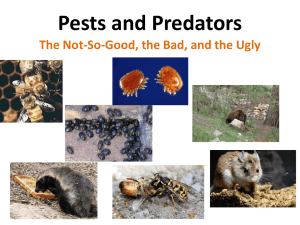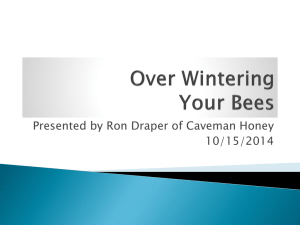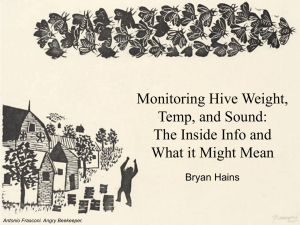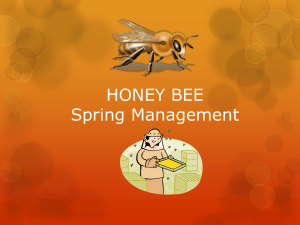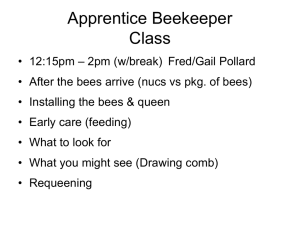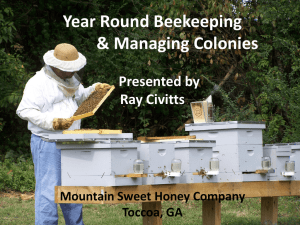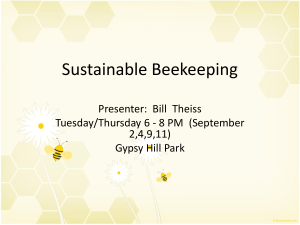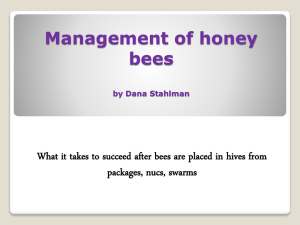Diseases, Pests and queenlessness
advertisement
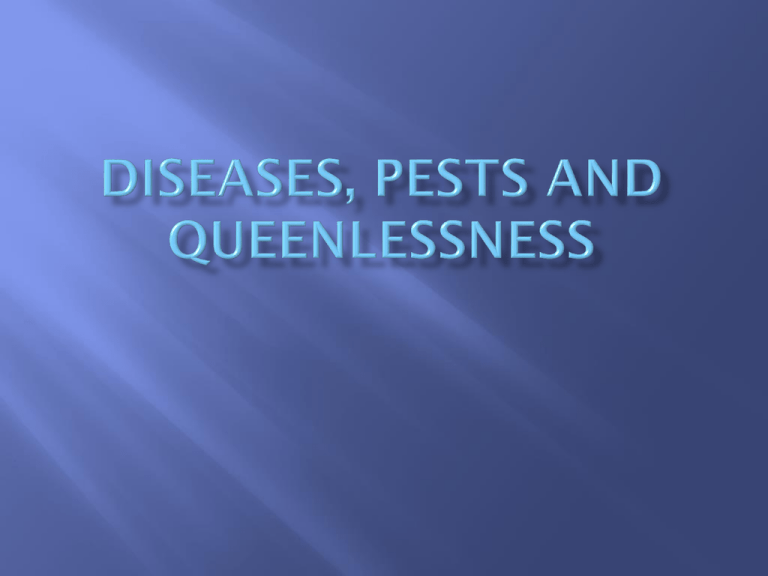
Varroa mites (Varroa destructor) are small, reddish-brown tick like pests which feed on the hemolymph (“blood”) of the honey bees. It will create cuts on your bees that can gain infection as well as transmit viruses. Mites will gravitate to Drone cells more often because of the time period in which it is capped (14 days). There are two widely used methods to assess the mite levels in your hive. Corex Sheet. This is a sheet which slides under a screened bottom board. Spray the corex sheet with a cooking oil so when the mites fall from the hive they stick to the sheet and can then be counted. Insert the sheet for 3 days and then remove it to count the mites. Once you have a total, divide it by 3 to get the average mite drop in a 24 hour period. Sugar Shake. Place a few table spoons of powdered sugar in a mason jar and gently "slosh" some bees (about ½ cup) around ensuring they are fully coated. Replace the lid with #8 hardware cloth and the sugar will dislodge the mites allowing them to fall through the screen. Below is a very general guide to determine if the colony should be treated. However, the prevailing thought is if you have a window of opportunity to treat your colony you should treat. Sampling Method Spring Fall Corex Sheet 5-10 mites 50-60 mites Sugar Shake 3-4 mites 10-12 mites Integrated Pest Management (IPM) methods work with the behavior and biology of the target pest to aid in its control. Several methods that can control the mite population include: • • A screened bottom board which allow the mites to fall out of the hive Drone trapping/Varroa trapping using a Drone frame or Drone foundation Remove frame after cells have been capped and freeze for 48 hours. Reinstall frames after thawing. IPM methods often are not a sufficient form of control and pesticides need to be used. It is strongly encourage the use of “soft chemicals”. These are naturally occurring products and many naturally existing in honey. The two most common are Api Life VAR and MiteAway Quick Strips. Api Life VAR is made with thymol, which is used in mouthwash, and other essential oils. Evaporative wafers are placed on the hive and the thymol vapor kills the varroa. MiteAway Quick Strips use food grade formic acid, which naturally occurs in honey. Another product that is coming on the The small hive beetle is a small uniform dark brown to black beetle about 5-7mm long with “clubbed” antennae. The adult beetles are usually found toward the back of the hive on the bottom board, but can often be seen along the frame rests or running along the edges of the inner cover. The females will lay egg masses in protected crevasses in the hive. The larva feed on the honey and pollen. If the infestation is severe enough the bees will abandon the hive. As they move about the hive they defecate forming a slimy mess which results in the honey fermenting. Once the larva have matured they will leave the hive and burrow into the soil. There they will pupate into adult beetles. Soil conditions and temperature affects their ability to reproduce. The sand loams of southern regions are ideal for the larva once out of the hive, however, winters in the north retard the population growth. Prevention • Maintaining healthy bee colonies that are capable of protecting all comb in the hive is desirable in preventing small hive beetle problems. • Removing excess supers of unprotected honey and empty comb from the hive is highly recommended. • Beekeepers should avoid leaving filled honey supers standing in the honey house for more than a day or so. • Purchasing colonies, packages, and nucs from reliable sources that have been certified beetle free is highly recommended. • Beetle Jail • Beetle Blaster • Hood Small Beetle Trap Control Beetle Jail Beetle Blaster Hood Small Beetle Trap Nosema is both the name of a condition and the organism which causes it. In the U.S. we have two species, Nosema apis and Nosema ceranae. Both species are a unicellular fungus which resides in the gut of the bee The parasite has a polar tube that penetrates cells of the bee Injects the necessary elements for reproduction into the cell. Inside the cell of the bee’s gut, Nosema reproduces by forming spores Spores are passed within the bee’s waste Nosema Apis is most problematic in the winter and spring Bees will begin to expel waste in the hive and on the outside Brown spotting on the outside of the hive will appear Nosema ceranae can affect a hive at any time of the year Can cause rapid colony decline No symptoms will be present Both forms of Nosema are treatable with Fumagilin-B. Fumagilin-B is an antibiotic which restricts the “firing” of the polar tube. If the parasite is unable to attach to the cells of the bee’s gut it cannot reproduce. Researchers now recommend treating with Fumagilin-B Spring and Fall. Tracheal mites are microscope mites which reproduce in the trachea (airways) of the bee. A visual aid that would suspect tracheal mites would be a large number of bees walking about the outside of the hive. Female mites lay and attach eggs in the trachea Eggs mature in 2-3 weeks after hatching Female mites migrate to the surface of the bees The mites affect the bee in two fashions that limit the bees ability to acquire oxygen. The mites physically obstruct the airway. The mites feed on the walls of the trechea causing scarification of the tracheal tubes. Treatment The traditional method of treating for tracheal mites is the use of menthol crystals which are placed on the top of the hive. As the menthol evaporates, it enters the trachea of the bees thus killing the mites. An alternative treatment is a mixture of powdered sugar and Crisco. The bees go after the sugar and get covered with the Crisco. This interferes with the mite's ability to detect the young bees. As a result, the mite remains on the older bee and eventually dies with the bee. Be cautious with this treatment because it can attract hive beetles. If you suspect Tracheal mites then you want to treat for the mites and then requeen. The Wax Moth is a very destructive insect pest in the beehive. The adult moth is a heavy bodied small moth about ½” to ¾” long, wings vary in color from grayish to brown and the underside is light gray. The mated females will fly into a colony 1 to 3 hours after dark and lay their eggs and then leave before daylight. The eggs are laid in masses and are light in color. A fat larvae worm will be visible Larvae is pointed at both ends with a brown head and can get up to 1" in length Will stay in the larvae state from 18 days to 3 months Prefer darker comb and will chew out oval depressions throughout your hive Will destroy the comb and woodenware Begin spinning a cocoon that can cover your frames Immediate action needs to be taken if a web has already been spun There are no chemicals approved to kill these wax worms while in your hive. The only sure way to keep this from becoming a problem in your hive is to keep your bees strong and healthy so they can manage them successfully on their own. Depending on the extent of the problem you have several options; remove the infected super and add it to a very strong colony that will clean it up, place the comb inside a plastic bag and place in a freezer for 2 days, or some in the deep south, will place the infested combs over a fire ant nest for a day or so to clean up. If you make cut comb honey it is necessary to freeze your comb for at least 2 days, this will kill the eggs and prevent them from hatching inside the packaging. Extracting supers can be treated with Paradichlorobenzene (PDB). Simply stack the extracted dry supers about 5 high (hive bodies) or 10 high (supers) and place 6 oz. of the crystals on top of a square of newspaper in the top super. It is necessary to make sure that all cracks are taped shut; you are basically making a fumigation chamber. Check your stacked supers every 6 weeks if you live in a warm climate as the moths may get back into the stacked supers and lay more eggs when the PDB has vaporized. Make sure that the supers are aired out for several days before placing back on the hive. Use only the PDB, DO NOT use commercially available moth balls; it has other chemicals that are unsafe for bees and humans. Losing the queen is a common problem and obviously will mean the death of the colony if not corrected. A good beekeeping practice is to inspect your colonies at a minimum of every two weeks paying close attention to the queen or at least looking for eggs. Some reasons colonies lose queens are: A virgin queen who doesn’t return from the nuptial flight A colony that swarms without successfully leaving a queen behind A failed supercedure effort Age, frailty, disease or injury During inspections, in the absence of actually seeing the queen, the presence of eggs is sufficient to know that you have a queen and that she is laying. If the colony has no eggs it means that either the bees are preparing to swarm, or there hasn’t bee a laying queen in the last 3 days. If there is no uncapped larva, no laying has occurred in 10 days. By this point, the colony should have attempted to create a queen – assuming they had the resources early on (eggs are necessary for queen creation). If the colony is queenless for 3 - 4 weeks they will spawn a laying worker. If your issue is simply a queenless colony, without a laying worker, then requeening is advised. Obtain a mated queen from a reputable source Purchased, mated queens are shipped in a queen cage – a queen with a few attendants. There is a cork on one end, blocking the exit from the bees inside. Under the cork is a sugar seal. Remove the cork, place small nails or brads in the cage and hang the cage in the hive. Before closing the hive, pay close attention to the behavior of the bees to the cage. If they mob the cage and cannot be brushed off easily, they are having a hostile reaction to the queen and will most likely kill her. In this event, remove the queen cage and wait a day or two. Try again. If the bees seem accepting of the new queen, return in 2-3 days. The queen cage should be empty. In another week, inspect the hive. You should find eggs, if not the queen herself. If you see something similar to this and you have about half the number of bees in your hive then your bees have swarmed. If you have no eggs you probably have a virgin queen in your hive that hasn’t mated yet and started laying. Come back in two weeks.
